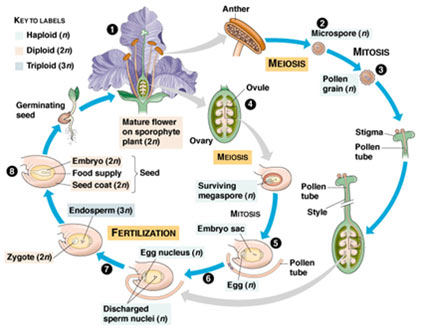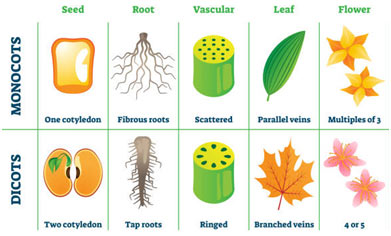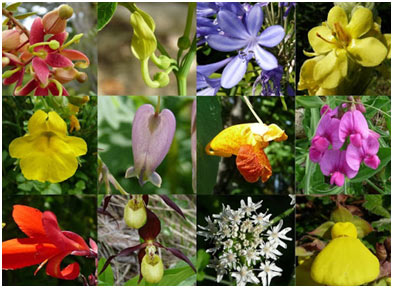What are Angiosperms?
The term angiosperms means “enclosed seeded” (Angio= close; Sperm = seed).
- In these plants, fertile leaves bearing ovules are folded and joined at the margins to form ovaries.
- The ovary after fertilization becomes a fruit, including seeds.
- Angiosperms comprise 235,000 of the 360,000 known species of plants.
- They are heterosporous, autotrophic plants.
- These are highly evolved of all the plants on the earth.
- The plants produce flowers, fruits, and seeds.
- The angiosperms or flowering plants appear in the fossil record during the Cretaceous period, 135 million to 70 million years ago.
- Because of this duration, they have ended up being the dominant kind of plants on land throughout the world.
- There are about 300000 species of angiosperms– more than all the other plant species assembled.
- They offer important food sources for mankind in the form of cereals, root crops, leaf crops, and fruits. Other essential products consist of textiles, drugs, vegetable oils, rope, timber, and fuel.
- 1) Characteristics of Angiosperms
- 2) Life Cycle of an Angiospermic Plant
- 3) Seed Formation
- 4) Double Fertilization
- 5) Classification of Angiosperms
- 6) Monocotyledonous plants
- 7) Dicotyledonous plants
- 8) Multiple-Choice Questions (MCQs) on Class Angiospermae: Characteristics, Life Cycle, Classification
- 9) Frequently Asked Questions (FAQs)
- 10) Summary – Class Angiospermae Tutorial
- 11) You may also like to learn:
Characteristics of Angiosperms
Angiosperms have varied attributes. The essential attributes of angiosperms are mentioned below:
- All plants have flowers at some phase in their life. The flowers are the reproductive organs for the plant, supplying them with a method of exchanging genetic information.
- The sporophyte is separated into stems, roots, and leaves.
- They have a true vascular system i.e., proper xylem and phloem.
- The stamens (microsporophyll) and the carpels (megasporophyll) are arranged into a structure called the flower. Each microsporophyll has 4 microsporangia.
- The ovules are confined in the ovary at the base of the megasporophyll.
- Angiosperms are heterosporous, i.e., produce two types of spores, microspore (pollen grains) and megaspores.
- A single functional megaspore is completely maintained within the nucellus.
- The pollen grains transfer from the anther to stigma and recreation occurs by pollination. They are accountable for the transfer of hereditary information from one flower to the other. The pollen grains are much smaller sized than the gametophytes or reproductive cells present in the non-flowering plants.
- The sporophytes are diploid.
- The root system is very intricate and consists of the cortex, xylem, phloem, and epidermis.
- Angiosperms can make it through in a variety of environments, including marine environments.
- The procedure of fertilization is fast in angiosperms. The seeds are also produced rapidly due to the smaller sized female reproductive parts.
- The carpels confine developing seeds that might develop into a fruit.
- The production of the endosperm is among the best benefits of angiosperms. The endosperm is formed after fertilization and provides food for the developing seed and seedling.
Life Cycle of an Angiospermic Plant
The adult plant is a diploid sporophyte mainly differentiated into roots, stems, and leaves. At maturity it produces flowers. A flower is a modified shoot that consists of a pedicel, thalamus or torus, and floral leaves (sepals, petals, stamens, and carpels). Thalamus and floral leaves, especially the stamen and the carpels, are so modified, that they do not even appear like stem and leaves respectively. The sepals and petals are non-necessary or non-reproductive parts, and stamens and carpels are the essential or reproductive parts of the flower.
The sepals and the petals secure the stamens and the carpels. They likewise attract insects for pollination. When the pollination is over, the petals always fall off. The anther contains microspore mother cells which produce haploid microspores through meiosis. Each microspore sprouts to produce male gametophyte. Such microspores containing male gametophytes are called pollen.
The carpel consists of a basal broader part, the ovary, the style, and the terminal part of the style, the stigma. The ovary includes ovules. The ovule consists of an integument (covering) and tissue, the nucellus present inside.
After pollination, the pollen grain is transferred to the stigma. Here it germinates to form a pollen tube. The nucleus of the microspore divides by mitotic divisions to form two male gametes and the tube nucleus. At this stage of development, the pollen grain is called male gametophyte. In the meantime, particular modifications happen in the ovule causing the formation of female spore (megaspore). The megaspore turns into a female gametophyte. This includes 7 cells just. One of these cells is the egg or oospore.
The pollen tube grows through the style, goes into the ovule, and then reaches the female gametophyte. Here it releases the male gametes. The egg and one of the two male gametes fuse to form the oospore. The second male gamete fuses with the secondary nucleus to form endosperm nucleus (double fertilization). The oospore turns into an embryo and the endosperm nucleus develops into a multicellular nutritive tissue, the endosperm.

Seed Formation
Meanwhile, the integuments of the ovule form testa and tegmen and ovary wall become the fruit. Seeds normally undergo a period of rest and after that under ideal conditions, germinate and produce a seedling that gradually becomes a sporophyte. Hence an alternation of dominant sporophyte generation(2n) accompanies inconspicuous gametophyte generation(n).
Double Fertilization
Double fertilization is a special process found in Angiosperms. These two male gametes fuse with two cells concurrently. A male gamete (n) fuses with egg (n) to form a diploid zygote (2n) which develops later into an embryo and 2nd male gamete (n) fuses with another female cell called fusion nucleus (2n) resulting in a triploid (3n) endosperm cell, which develops into food storing endosperm tissue. It is an important evolutionary development in which food storage in fertilized ovule is made only on fertilization i.e., development of the zygote. This really assists the plant to economize its food resources.
Classification of Angiosperms
Based upon the kinds of cotyledon present, angiosperms are divided into two classes. They are monocotyledons and dicotyledons. The dicotyledonous angiosperms have two cotyledons in their seeds and the monocotyledonous angiosperms have one cotyledon.
Monocotyledonous plants
The monocots have some unique functions that consist of the presence of adventitious roots, simple leaves with parallel venation, and trimerous flowers. The number of vascular bundles is more and is closed. Some of the examples consist of bamboos, sugarcane plants, bananas, cereals, lilies, and so on.

Dicotyledonous plants
The dicotyledonous plants have two cotyledons with a tap root system. The venation seen in the leaves is reticulate. Flowers can be tetramerous or pentamerous. Vascular bundles are typically organized in a ring and number between 2 to 6. Examples consist of Grapes, Dandelions, Sunflower, Tomatoes, and Potatoes, etc.
Multiple-Choice Questions (MCQs) on Class Angiospermae: Characteristics, Life Cycle, Classification
- What does the term “Angiosperms” mean?
- A) Open-seeded
- B) Closed-seeded
- C) Seeded fruits
- D) Non-seeded
Answer: B) Closed-seeded
- How many known species of plants do Angiosperms comprise?
- A) 100,000
- B) 200,000
- C) 300,000
- D) 400,000
Answer: C) 300,000
- When did Angiosperms appear in the fossil record?
- A) Jurassic period
- B) Triassic period
- C) Cretaceous period
- D) Paleogene period
Answer: C) Cretaceous period
- What is the primary purpose of flowers in Angiosperms?
- A) Photosynthesis
- B) Reproduction
- C) Water absorption
- D) Storage
Answer: B) Reproduction
- Which of the following is a characteristic of Angiosperms?
- A) Lack of vascular system
- B) Non-reproductive flowers
- C) Heterosporous reproduction
- D) Lack of true roots
Answer: C) Heterosporous reproduction
- What is the function of the ovary in Angiosperms after fertilization?
- A) Produces pollen
- B) Develops into a fruit
- C) Forms the stem
- D) Facilitates pollination
Answer: B) Develops into a fruit
- Which part of the flower is responsible for pollen production?
- A) Stigma
- B) Sepals
- C) Anther
- D) Ovary
Answer: C) Anther
- What is double fertilization in Angiosperms?
- A) Fusion of two eggs
- B) Fusion of two pollen grains
- C) Fusion of a pollen grain with an egg and a fusion nucleus
- D) Fusion of two sperms
Answer: C) Fusion of a pollen grain with an egg and a fusion nucleus
- What is the primary function of endosperm in Angiosperms?
- A) Protection of seeds
- B) Storage of food
- C) Facilitation of pollination
- D) Formation of fruit
Answer: B) Storage of food
- How many cotyledons do dicotyledonous plants have?
- A) One
- B) Two
- C) Three
- D) Four
Answer: B) Two
- Which class of Angiosperms has simple leaves with parallel venation?
- A) Monocotyledonous plants
- B) Dicotyledonous plants
- C) Both
- D) Neither
Answer: A) Monocotyledonous plants
- What type of roots do monocotyledonous plants typically have?
- A) Tap roots
- B) Adventitious roots
- C) Fibrous roots
- D) Aerial roots
Answer: B) Adventitious roots
- How are the vascular bundles arranged in dicotyledonous plants?
- A) Scattered
- B) Closed
- C) Parallel
- D) Ring
Answer: D) Ring
- Which part of the flower protects the stamens and carpels?
- A) Petals
- B) Sepals
- C) Ovules
- D) Stigma
Answer: B) Sepals
- What is the main purpose of the pollen tube in Angiosperms?
- A) Transport of water
- B) Facilitation of photosynthesis
- C) Transfer of genetic information
- D) Formation of seeds
Answer: C) Transfer of genetic information
- In Angiosperms, what is the male gametophyte called?
- A) Pollen
- B) Ovule
- C) Endosperm
- D) Embryo
Answer: A) Pollen
- When does the process of double fertilization occur in Angiosperms?
- A) Before pollination
- B) During germination
- C) After pollination
- D) During seed formation
Answer: C) After pollination
- What evolutionary advantage does double fertilization provide in Angiosperms?
- A) Increased seed production
- B) Economizing food resources
- C) Rapid germination
- D) Enhanced pollination
Answer: B) Economizing food resources
- How many cells does the female gametophyte in Angiosperms typically have?
- A) 3
- B) 5
- C) 7
- D) 9
Answer: C) 7
Frequently Asked Questions (FAQs)
1. What do Angiosperms mean?
- The term “Angiosperms” literally means “enclosed seeded.” It refers to plants with fertile leaves bearing ovules that are folded and joined at the margins to form ovaries.
2. How many species do Angiosperms comprise?
- Angiosperms comprise approximately 235,000 of the 360,000 known species of plants.
3. When did Angiosperms appear in the fossil record?
- Angiosperms appeared in the fossil record during the Cretaceous period, approximately 135 million to 70 million years ago.
4. What are the essential characteristics of Angiosperms?
- Angiosperms have varied attributes, including flowers as reproductive organs, a true vascular system, heterospory, diploid sporophytes, and a complex root system. They can survive in diverse environments.
5. What is the significance of flowers in Angiosperms?
- Flowers serve as the reproductive organs, providing a means for the exchange of genetic information between plants.
6. How does the fertilization process occur in Angiosperms?
- Fertilization in Angiosperms involves pollen grains transferring from the anther to stigma, leading to pollination. The carpels then confine developing seeds that may develop into fruits.
7. What is double fertilization in Angiosperms?
- Double fertilization is a unique process where two male gametes fuse with two cells simultaneously, resulting in the formation of a diploid zygote and a triploid endosperm cell.
8. How does the life cycle of an Angiospermic plant progress?
- The life cycle involves an adult diploid sporophyte producing flowers, leading to pollination, fertilization, and seed formation. The alternation of dominant sporophyte and inconspicuous gametophyte generations occurs.
9. What is the role of endosperm in Angiosperms?
- Endosperm, formed after fertilization, provides food for the developing seed and seedling, contributing to the plant’s nutrition.
10. How are Angiosperms classified?
- Angiosperms are classified based on the types of cotyledons present into monocotyledons (one cotyledon) and dicotyledons (two cotyledons).
11. What are the characteristics of monocotyledonous plants?
- Monocots have features such as adventitious roots, simple leaves with parallel venation, and trimerous flowers. Examples include bamboos, sugarcane, bananas, cereals, and lilies.
12. What defines dicotyledonous plants?
- Dicotyledons have two cotyledons, a taproot system, reticulate venation in leaves, and flowers that can be tetramerous or pentamerous. Examples include grapes, dandelions, sunflowers, tomatoes, and potatoes.
Summary – Class Angiospermae Tutorial
The Class Angiospermae tutorial provides an in-depth exploration of the characteristics, life cycle, and classification of angiosperms, or flowering plants. Here’s a concise summary:
Introduction to Angiosperms:
Angiosperms, meaning “enclosed seeded,” are plants with fertile leaves forming ovaries after folding and joining at the margins. Comprising 235,000 species, they have evolved as the dominant plant type on Earth. Angiosperms contribute significantly to human sustenance, providing food, cereals, root crops, leaf crops, and fruits, along with various essential products.
Characteristics of Angiosperms:
- Angiosperms exhibit diverse attributes, including flowers as reproductive organs, true vascular systems, heterospory, and diploid sporophytes.
- They possess complex root systems and can thrive in various environments, including marine settings.
- Angiosperms undergo rapid fertilization, resulting in the production of seeds and the formation of endosperm, a crucial nutritional tissue for developing seeds and seedlings.
Life Cycle of an Angiospermic Plant:
- The life cycle involves an adult diploid sporophyte producing flowers, leading to pollination, fertilization, and seed formation.
- Specialized structures, such as sepals, petals, stamens, and carpels, play essential roles in the reproductive process.
- Double fertilization is a distinctive feature, leading to the formation of a diploid zygote and a triploid endosperm cell.
Seed Formation:
- After fertilization, integuments of the ovule form testa and tegmen, while the ovary wall transforms into the fruit.
- Seeds undergo a period of rest and, under suitable conditions, germinate to produce seedlings, initiating a new sporophyte generation.
Classification of Angiosperms:
- Angiosperms are classified based on cotyledon presence into monocotyledons (one cotyledon) and dicotyledons (two cotyledons).
- Monocots and dicots exhibit distinct features in root systems, leaf venation, flower arrangement, and vascular bundle organization.
The tutorial concludes by encouraging further reading on related topics, providing a comprehensive overview of the Class Angiospermae and its fascinating characteristics, life cycle, and diverse classifications.

